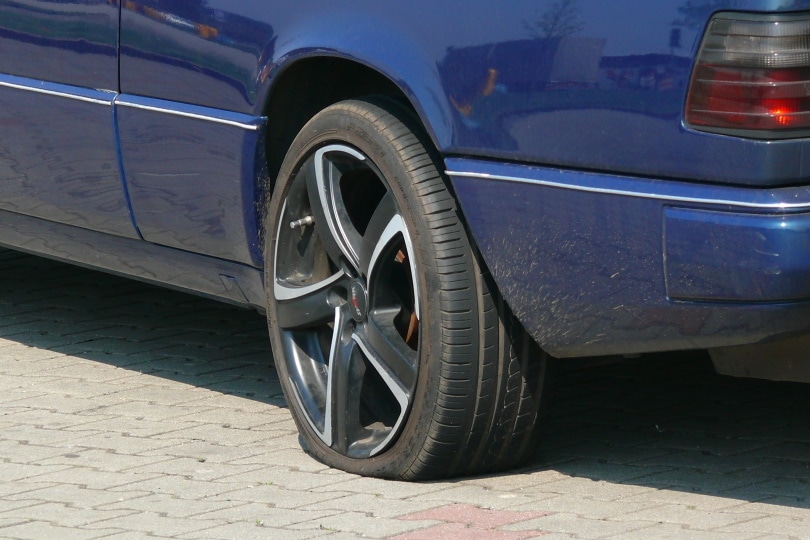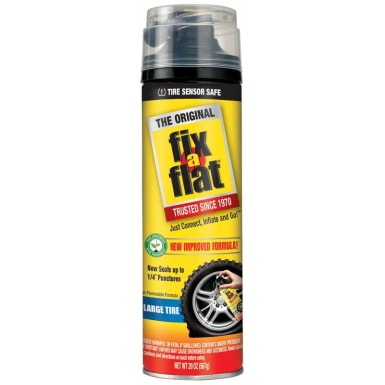How Does Fix-a-Flat Work? What You Should Know
-
Codee Chessher
- Last updated:

We’ve all been there: you’re driving down the road when your tire suddenly gives out. Fix-a-Flat gets you going just long enough to change or otherwise plug the tire, but it’s not magic. This miracle product is a must-have in every car emergency kit, but few people know exactly what it does.
In this article, we’ll cover exactly what’s in Fix-a-Flat, how it works, and much more. Let’s dive in with the details below.
What Is Fix-a-Flat and How Does It Work?
You’re probably thinking a useful product like Fix-a-Flat must be obscenely complicated, but you’d be wrong. Fix-a-Flat really boils down to two things: liquid propellant and a liquid latex tire sealant. When you plug the can up into your tire and press the button, the propellant and air inside force the latex tire sealant out and into your tire.
The propellant goes into your tire, and the latex emulsion hardens and seals itself within the hole. Sounds simple, right? Well, it’s a bit more complex than that. For instance, you’ve probably wondered how that tiny 16-ounce can is able to inflate your tire. No, we promise it isn’t magic—it’s taking advantage of the phase change that happens when gas becomes liquid.
The propellant inside is a gas at room temperature but compresses down to a fraction of its gaseous size to fit within the can as a liquid. When you use Fix-a-Flat, the liquid evaporates into a gas and expands to fill your tire. The propellant of choice is hydrofluorocarbon (HFC)-134a, which is also used in A/C units to keep your house cool.
You’re probably wondering, “What about the sealant? Surely that’s magic.” Nope! The latex emulsion that actually plugs your tire is composed of several different chemicals with nearly unpronounceable names, and they each serve a critical function in keeping your tire plugged. Let’s briefly check out those ingredients and what they do in Fix-a-Flat.
- Polymer Latex: A solution that foams up to plug your tire, latex is also used in paint, clothing, and more
- Heavy Aromatic Solvent Naphtha: Related to the same stuff in lighter fluid, this chemical acts as a binder to hold the other ingredients together inside your tire
- Polymeric Olefins: Part of the plastic-petroleum family, this combines with the polymer latex to form a stronger and more flexible seal
- Aromatic Resins: When you spray Fix-a-Flat into your tire, these resins are used to keep the latex and plastics in place
Together, these ingredients keep your tire inflated long enough to limp over to a mechanic or change the tire yourself. Fix-a-Flat themselves recommend removing it or changing the tire within 3 days or 100 miles.
Fix-a-Flat’s changed a lot over the years, though you probably haven’t noticed. It used to contain dimethyl ether as a propellant, which is extremely flammable. When Shell bought the Fix-a-Flat brand, they nixed the ether and switched to the HFC-134a that’s still currently used.
The bad news is that HFC–134a is a greenhouse gas that contributes to manmade climate. Europe is looking very hard at banning propellants like HFC-134a, which would force Shell to once again alter the Fix-a-Flat formula. It’s very possible that the US will follow suit.
What Are the Different Types of Tire Sealants?
Fix-a-Flat may be the most well-known tire sealant, but it’s far from the only one on the market. While Fix-a-Flat is an aerosol tire sealant, other brands may come in liquid form.
The main difference is that aerosols like Fix-a-Flat contain their own propellant, while liquid sealants require you to have a pump or air compressor to push the sealant into the tire. As you can imagine, that’s a lot of work, but liquid sealants have the advantage of lasting longer than aerosols. Lastly, some premium all-in-one kits contain both a liquid sealant and an air compressor.
Where Is Fix-a-Flat Used?
Fix-a-Flat is mainly used to get your tire going long enough for you to change or plug the tire, but it can be used for most machines with wheels. Fix-a-Flat itself doesn’t recommend using it for anything but cars, but it’s widely used to plug holes in bike tires, motorcycle tires, lawn mower tires, and more.
The results aren’t pretty, but Fix-a-Flat’s always been a messy stopgap measure to keep you going until you can change the tire in question. Many people try to use it as a permanent or semipermanent tire sealant, which leads to outrage when it inevitably fails.
Seriously, don’t use Fix-a-Flat like it’s a magic tire repair kit. It’s just a temporary fix, and many mechanics won’t even touch tires that have Fix-a-Flat or other sealants in them. We recommend keeping a can around for emergencies, but that’s the extent of its usefulness.
Lastly, we have to touch on cold weather. Fix-a-Flat’s formula can freeze, expand, and crack in freezing weather, so people in colder climes may need another emergency tire solution.
Advantages of Fix-a-Flat
- Inflates and plugs punctured tires
- Easy to use
- Lasts 3 days or 100 miles, so you have time to find a more permanent solution
- Works quickly
Disadvantages of Fix-a-Flat
- Not a permanent solution
- Won’t work for large punctures, slashes, or sidewall damage
- May clog your tire pressure sensor in some cases
- Not suitable for use in freezing weather
- Can cause uneven tire wear
Frequently Asked Questions (FAQs)

Do I need to add more air after using Fix-a-Flat?
In a lot of cases, yes. Fix-a-Flat only has enough propellant to inflate your average tire about a quarter of the way. If your tire’s gone completely flat, Fix-a-Flat will get you going long enough to find a gas station with an air pump. Alternatively, you can invest in a portable air compressor so you won’t have to worry about this problem again.
How long does Fix-a-Flat last once used?
Officially, Fix-a-Flat recommends removing it after 3 days or 100 miles. That doesn’t necessarily mean that it won’t last longer, but all bets are off on its reliability afterward. Some people claim they’ve driven for months or years after using Fix-a-Flat, but that’s not a great idea. If it fails, you’re right back in the same situation you started in. To be safe, just have it repaired or change the tire ASAP.
Can you use Fix-a-Flat for tires with multiple punctures?
You can, but there are a few compelling reasons not to. Firstly, you might miss a puncture and end up with a flat tire again. If you’ve run over, say, a bunch of nails, Fix-a-Flat probably isn’t a good treatment.
Another good reason is that a tire with multiple punctures will eventually start leaking air because each puncture is another point of failure. If Fix-a-Flat doesn’t work perfectly in every hole, you’re in trouble.
Finally, Fix-a-Flat is less effective at sealing multiple punctures if they’re within 16 inches of each other, and most repair shops won’t touch your tire in such a case.
Should I remove the nail or other foreign object from my tire before using Fix-a-Flat?
Yes, you should try to remove the object stuck in your tire before using a can of Fix-a-Flat. It makes a certain kind of sense that Fix-a-Flat would fill in the gap around the object, but that’s not the case. Fix-a-Flat’s latex sealant can’t properly adhere and harden with the object still in your tire. If it’s really stuck in there, you may be able to use Fix-a-Flat to drive a short distance to repair or replace the tire.
Conclusion
Fix-a-Flat is a lifesaver when you’re stranded with a fresh flat tire, but it’s not a miracle fix. You should only use it to temporarily plug holes in order to change or repair the tire. Preferably, you’d drive straight to a mechanic or home, but we can’t tell you how to live your life. Regardless, Fix-a-Flat is a staple accessory in any car emergency kit.
Featured Image Credit: Piqsels
Contents


